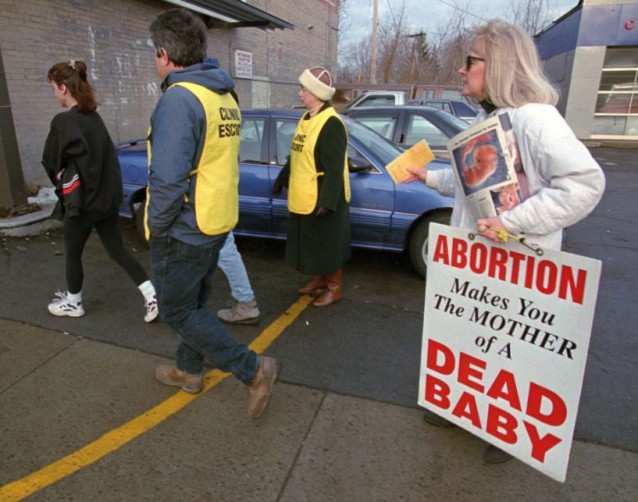
The Supreme Court of the United States ruled unanimously today that Massachusetts’ abortion clinic buffer zone ruling is unconstitutional. In 2007, the state amended the state-wide Reproductive Health Care Facilities Act to make it illegal to congregate within 35 feet of the entrance of an abortion clinic, including on public sideways and roadways.
The amendment was implemented to directly address an oft-used tactic by the anti-choice Right: the harassing and abusive screeching and finger-wagging that seeks to shame women entering clinics for seeking an abortion (whether they are actually doing so or not).
The SCOTUS decision paints a euphemistic picture of this strategy, labeling it the righteous exercise of free speech. They call it “sidewalk counseling” and refer to two tactics they’ve now ruled as protected by the First Amendment: the right to close person-to-person contact between protester and patient, and the right to distribute literature.
This is a disingenuously charitable description of what these protesters actually do.
The internet abounds with first-person accounts of the tactics adopted by abortion clinic protesters. Escorts describe protesters holding up grisly signs — several feet high and wide — depicting aborted late-term fetuses (a procedure illegal in most states), of protesters mobbing young women emerging out of their cars, of protesters hurling insults and warning that the women will burn in hell. They call clinic employees “Nazis”, women seeking abortions “murderers”, and position themselves in front of clinic doors crying out “Can you hear the babies crying? Mommy! Mommy! Mommy!“.
This isn’t a casual intimate conversation about the pros and cons of abortion. This is horrific, shameful verbal abuse.
Buffer zones have a documented efficacy in Massachusetts and other states where they are in effect around abortion clinics. The buffer zone rule was first adopted following a mass shooting at an abortion clinic. Since its passage, three-fourths of abortion clinics surveyed by the National Abortion Federation (NAF) report that buffer zones have substantially improved access to the clinics for their patients, and most also report a decrease in local crime rates.
Buffer zone detractors argue that the law limits specific kinds of free speech by permitting clinic escorts — employees of abortion clinics whose job it is to help patients find the front door — to stand within 35 feet of the abortion clinic. Yet, this seems like a red herring to me: of course employees should be able to access their place of employment. Meanwhile, both pro- and anti-choice protesters are prohibited from protesting within the 35-foot buffer zone, regardless of political stance.
Yet, it is based on this bizarre interpretation of the buffer zone rule as disproportionately impacting anti-choice protesters that SCOTUS ruled to strike it down. The decision issued today argues that buffer zones in Massachusetts “serve the Commonwealth’s legitimate interests in maintaining public safety … and in preserving access to adjacent reproductive healthcare facilities”, but that these interests do not outweigh the zones’ burden on free speech.
I get that the First Amendment protects the right to free speech, but the Court has also ruled that speech that impedes access to other rights can take a backseat. In the specific example of buffer zones, the Court has upheld their use at polling places, at State capitol buildings, and even around the Supereme Court building. So what makes abortion clinics different? As far as I can tell, the only difference is that the Supreme Court believes preventing voter disenfranchisement is more fundamental a right than the right to reproductive choice. The burden to free speech established by polling place buffer zones is outweighed by the need to prevent voter disenfranchisement, but the right to abortion access is not “important” enough to justify a buffer zone around abortion clinics.
If we needed any more evidence of the deplorable state of womens’ rights in this country, we need look no further than this ruling. And, this ruling may be of particular relevance to Asian American women, who some studies show are nearly twice as likely than women of other races to choose abortion due at least in part to cultural stigmas around sexual education and lack of family support for unplanned pregnancies.
That being said, in truth, whether protesters are within 35 feet or outside of 35 feet from the front doors of abortion clinics, they will continue to employ deplorable tactics to try and abuse and shame women seeking reproductive services at these clinics. Whether a woman is being called a murderer up-close or being yelled it from across the street, they are feeling the full impact of those words; words that can have particular impact for a women who may be undergoing the harrowing and vulnerable decision to get an abortion.
No law will prevent some from exercising their First Amendment right to be a raging asshole.
So, while the political fight continues to stem the tide of abortion clinic protesters and their terrible tactics, the best solution right now is not just to sign a petition or a letter (although, indeed, you should sign petitions and letters supporting reproductive choice!). It is also to volunteer your time at your local reproductive health clinic, to be an abortion clinic escort.
Donate your time to become a member of the clinic vanguard, protecting women from the daily hatespeech spewed by anti-choice protesters that SCOTUS has today deemed less burdensome to protect than the right for women to have unimpeded access to reproductive healthcare services.
Here’s some more information from NAF on how you can get involved. It may not seem like being an escort does much, but for women seeking an abortion, it can be everything.
